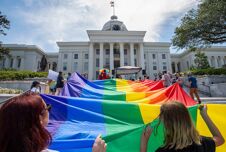The idea of someone transitioning while embedded with the Taliban sounds more like the plot of a dramatic movie than a real-life situation. But for Australian journalist Jordan Bryon, this was exactly where he found himself when Afghanistan fell to the Taliban in 2021. He had been living in the country for five years, providing coverage for The New York Times. While making these stories, his own very personal one emerged too, and it forms the basis of his documentary Transition, which premiered at Tribeca Film Festival in June.
This powerful, mind-blowing film combines hand-held footage with cinematic landscape shots and tightly framed interviews with Taliban members. It alternates between terrifying, funny, sweet and devastating. Bryon makes a jaunty but dedicated protagonist, one who has kept his trans identity a secret from his subjects.
Related:
Activists say life for LGBTQ+ Afghans has become unbearable under Taliban rule
They’re asking the rest of the world – and particularly the US – to wake up.
There are few points in this documentary where you can sit comfortably or calmly. It keeps you constantly on edge, waiting for some big reveal to go wrong, for Bryon to be discovered and attacked, or worse. But the moment doesn’t come. Instead, the multiple near misses – like waiting in the gender-divided line at airport security or Taliban members casually asking him how many wives he wants – keep us captivated, heart pounding.
Never Miss a Beat
Subscribe to our newsletter to stay ahead of the latest LGBTQ+ political news and insights.
There’s a moment when Teddy, Bryon’s friend and translator/fixer, asks the leader of the Taliban group what he thought of Bryon when they first met. “We’d never seen someone like Jordan before,” he replies. Your breath catches in your throat. Does he mean a trans person? But then – relief. No, he means Australian, white, and Arabic-speaking. And then, another twist. “You were very beautiful,” the Taliban says. A beautiful man. Does he know? But then the conversation swiftly, and thankfully, moves on.
It’s not clear what would have happened if they did find out about Bryon being trans. Being killed is certainly an option, one Bryon references multiple times. But of the Taliban members we meet in this film, there’s no obvious sense that trans people are their biggest concern. In fact, one of the most fascinating takeaways from the film is the fact that these Taliban members seem to care a lot less about trans people than people do back home in Bryon’s native Australia and, for that matter, in the USA and Europe.
Obviously, this is not the whole truth. Queer people in Afghanistan live in extraordinary danger every day. It’s also clear that the Taliban members with whom Bryon films are not necessarily representative of the group as a whole. The very fact that they have allowed this “infidel” into their lives – and with a camera, no less – is evidence enough that they hold specific boundaries not necessarily shared by other Taliban members.
Even within the group there is a difference of opinion. “Is it ok with the Taliban for a man to dress like a woman?” Teddy asks. “Yes,” says one man, before another cuts in from across the room. “No, no it is a problem.” They discuss this back and forth, and it’s evident that there aren’t really any fixed rules on this that they can agree on. The disagreeing member references Sharia law, but then agrees that it’s fine for a man to dress as a woman if it’s for a film role.
It’s not clear if this discussion stems from the fact that trans people simply aren’t known about there, or just not to these people. It’s not that the Taliban don’t engage with the issue of gender – they are notorious for their views on the position of women in society, which can be described as oppressive at best. But when it comes to trans people, there seems to be a gap in knowledge, and they can’t form an opinion on something they don’t know to consider.
There’s another big question that the film leaves us with, and it’s one that feels uncomfortable to ask, yet can’t quite be ignored: How will the Taliban members featured in the film – shown laughing, mock wrestling, eating with Bryon – feel and react on hearing that he is a trans man? The unease of asking this question sits with the fact that we don’t, or shouldn’t, really care what they think or feel. But this question isn’t borne out of concern for their emotional response to the truth, but rather from the deep psychological curiosity that this film evokes.
This film brings to light the lengths to which someone is willing to go in order to live as their authentic self. To an outsider, the idea of transitioning while embedded in the Taliban might seem unfathomable, but such is the power of gender dysphoria. Here we see someone choose to put their life at risk – and indeed the lives of those around them – for the sake of living authentically. For Bryon, there’s a sense that this isn’t really a choice at all. It was something he had to do, and for a mix of complex and nuanced reasons, found that it was easier to make this choice in Afghanistan rather than back home.
This is the central examination of Transition, an exploration of what it means to be trans in a situation where the risk is so high it would seem unthinkable to anyone else. What we also come to understand is that transitioning is always a risk, that the world is not safe for trans people anywhere. Bryon’s experience of being trans in Australia was unbearable, to the point that being trans somewhere as volatile and authoritarian as Afghanistan seemed like a better option.















